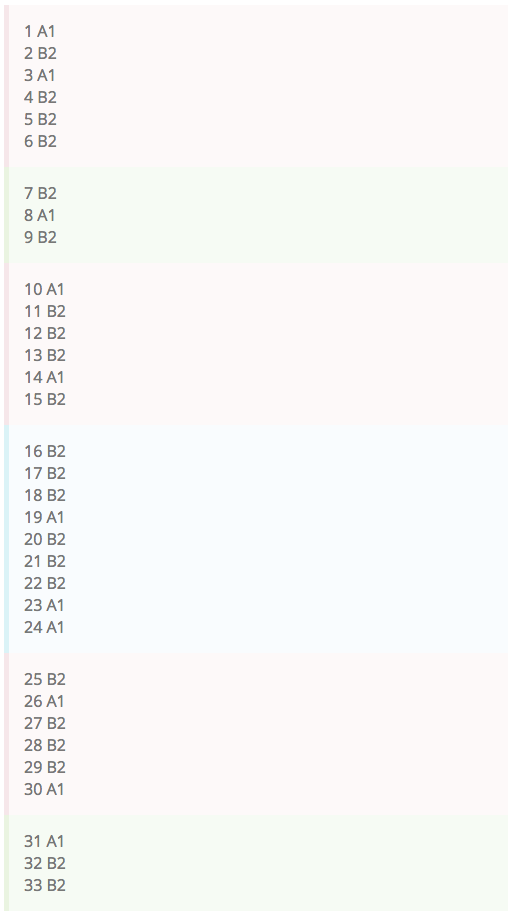The Permuted-Block algorithm determines treatment arm assignments by generating a group of blocks. Each block contains a predetermined number of treatment arm assignments based on the treatment arm allocations and the block multiplier. The block itself can also occur one or more times in the block group based on its own block group allocation.
As an example, given a Treatment Arm A with an allocation value of 1 and a Treatment Arm B with an allocation of 2, this indicates that we want 1/3 of the participants to ideally fall into Treatment Arm A and 2/3 into Treatment Arm B. The creates a base unit of size 3.
Next, we define two block size multipliers, the first we set to have a multiplier of x1 with a block group allocation of 1, and the second we set as having a multiplier of x2 also with a block group allocation of 1.
The algorithm can now generate the first block group. As both block size multipliers have an allocation of 1, the algorithm shuffles one of each into the block group giving us one of the following arrangements.
Block Group Block x2 Block x1
Block Group Block x1 Block x2
If we had set the second block size multiplier to have an allocation of 2 the algorithm would have generated one of the following block groups.
Block Group Block x2 Block x2 Block x1
Block Group Block x2 Block x1 Block x2
Block Group Block x1 Block x2 Block x2
For simplicity and brevity, this example will use block size multipliers with block group allocations of 1.
The algorithm now needs to insert the proper treatment arm assignments into each of these block size multlipliers. Starting with the simpler example, the Block x1 contains 1 base unit of treatment arms. Since the treatment arms have an allocation value of 1 for Treatment Arm A, and 2 for Treatment Arm B, for a total of three treatment arm assignments, these are shuffled and added to Block x1 to give one of the following results.
Block x1 Arm A Arm B Arm B
Block x1 Arm B Arm A Arm B
Block x1 Arm B Arm B Arm A
The same is done with Block x2. The only difference here is that the treatment arm multiplier is x2, so we take the allocation values of each treatment arm to come up with the following list: Treatment Arm A, Treatment Arm A, Treatment Arm B, Treatment Arm B, Treatment Arm B, Treatment Arm B.
Treatment Arm A occurs twice, and Treatment Arm B occurs four times in Block x2. These are once again shuffled and inserted into the block size multiplier. Here are two possible results.
Block x2 Arm B Arm B Arm B Arm A Arm B Arm A
Block x2 Arm B Arm A Arm B Arm B Arm B Arm A
The following shows how the Block-Permuted algorithm may generate an evenly distributed set of treatment options within a single Block Group.
Block Group Block x2 Block x2 Block x1
Block Group Block x2 Arm B Arm B Arm B Arm A Arm B Arm A Block x2 Arm B Arm A Arm B Arm B Arm B Arm A Block x1 Arm B Arm A Arm B
Generating Lists
When a subject is randomized using the Block-Permuted algorithm, the stratification factors are used to identify the list from which the algorithm should pull the next treatment arm assignment. Given gender (Male and Female) and site (Site A, Site B), a list would exist for each of these combinations. The following four lists would exist, "Male/Site A", "Male/Site B", "Female/Site A", and "Female/Site B". If a new treatment arm selection didn't exist, the Block-Permuted algorithm would then generate the next block group and append it to the appropriate list.
In-Depth Example of Treatment Block Group
The following image shows a single block group composed of two treatment arms and three different block size multipliers identified by color.
The treatment arms are:
- A1 Allocation 1
- B2 Allocation 2
The block group multipliers are:
- Green x1 Allocation 2
- Red x2 Allocation 3
- Blue x3 Allocation 1
Given this block group, the first participant would be randomized to A1, and the second participant to B2.

The 2 green blocks are block size multipliers that have a x1 occurence of treatment arm assignments, and have an allocation of 2 for the block group.
The 3 red block are block size multipliers that have a x2 occurence of
treatment arm assignments, creating 6 treatment assignments per block:
(1[A1] + 2[B2] = 3 treatment assignments)
(3 treatment assignments * x2 multiplier = 6 treatment assignments)
The red blocks have an allocation of 3 for the block group which is why the
red blocks appear three times.
Finally the single blue block is a block size multiplier of x3 containing a total of 9 treatment assignments within the block. The blue block has a block allocation of 1, and hence only shows up once in the entire block group.
Important notes:
- Each block group will have the same number of treatment assignments, in this case 33 per block group.
- An individual block may be allocated multiple times in the block group, with the same number of treatment assignments, but the treatment assignments may not be in the same order due to shuffling of each treatments within each block.
- Treatment arms get allocated to blocks and then get shuffled within the block.
- Each block as it is added to the block group shuffles the treatment arms indepently of other blocks.
- Blocks are allocated to block groups, and then get shuffled to fully create the block group.
- When treatment arm assignments are no longer available, a new block group is generated automatically by Slice.
